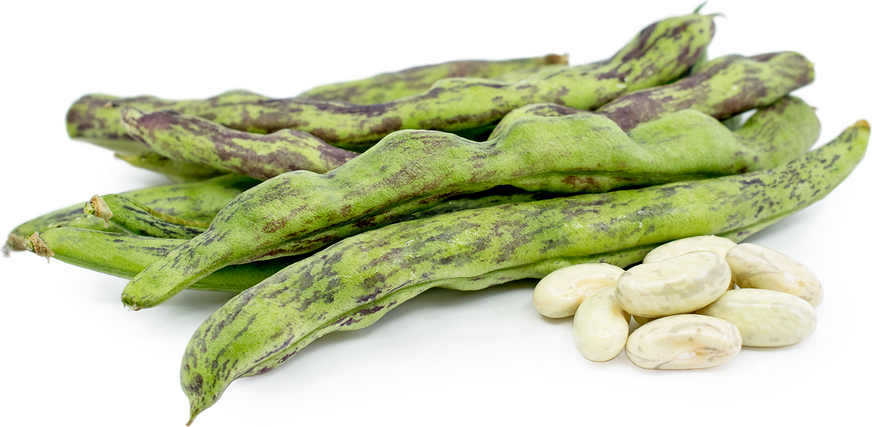


Rattlesnake Shelling Beans
Estimated Inventory, lb : 0
Description/Taste
Rattlesnake shelling beans are distinguished by their unique variegated marbling of purple and green on their exterior pods. Pod shape can vary from slightly to extremely curved and will reach six to seven inches in length when mature. The beans within the pods are ivory white when young and and as they mature will develop mottled markings of buff and chestnut tones. The shelled beans are smooth, semi-oval and curved. When fresh and young the bean pods offer a sweet snap bean flavor. Once mature shelled and cooked Rattlesnake beans will be plump with a meaty texture and offer a flavor similar to pinto beans, savory and nutty with subtle fruit nuances. When cooked whole as a fresh green bean the pods will lose their purple markings and turn to pure green.
Seasons/Availability
Rattlesnake shelling beans are available during the summer and fall months.
Current Facts
Rattlesnake shelling beans are a pole bean variety botanically known as part of Phaseolus vulgaris and a member of the Fabaceae family. They are a dual purpose bean and can be used whole as a fresh green bean when young or as a shelling bean when mature. Most commonly Rattlesnake beans are found in their dried and shelled form. Believed to be a relative of the popular pinto bean the Rattlesnake bean is also known in some parts of the southern United States as the Preacher bean.
Nutritional Value
Rattlesnake beans are rich in protein, fiber, folates, and vitamins A and B. Additionally they contain some iron, zinc, magnesium, calcium, copper and potassium.
Applications
Rattlesnake shelling beans are often classified as a "dry bean" because they are most often used in their dried form. The beans can be utilized fresh though for many different culinary purposes. When very young they can be blanched or sautéed whole and eaten like a green bean. Beans with more mature pods can be shelled fresh and used as you would a dry bean. Shelled beans can be simmered, sautéed, steamed, fried and baked. Rattlesnake beans make an excellent addition to soups, chili, casseroles, tacos and salads. Shelled beans can also be canned, frozen or dried and saved for future use. Complimentary ingredients include other shelling beans such as calypso and cranberry beans, garlic, shallots, herbs such as thyme, cilantro and arugula, fresh and aged cheeses, eggs, butter, olive oil, bacon, lamb and seafood such as prawns and crab. To store keep fresh unshelled beans refrigerated using within a week. Once shelled fresh undried beans will keep for a few days in refrigeration.
Ethnic/Cultural Info
There is much debate over the origin of the Rattlesnake bean’s namesake. Some sources say they are called such as a result of the beans markings that resemble that of a rattlesnake. Others indicate the name is the result of the bean pods' growth habit as they climb, twist and coil like a rattlesnake as they grow. Finally, others say it is from the way the beans when dried make a rattling sound within their pods.
Geography/History
Rattlesnake beans are believed to be native to the southwest region of North America where they were grown in ancient times by the Hopi Native Americans. Rattlesnake bean plants are prolific producers and will benefit from being trellised as vines can reach up to ten feet in height. Their two-toned exterior color makes them easy to find on the vines come harvest time. Rattlesnake shelling beans can thrive in hot, humid and even drought-prone climates. Today they are cultivated throughout the western and southern regions of North America.
Recipe Ideas
Recipes that include Rattlesnake Shelling Beans. One




